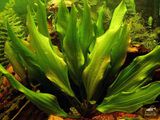Aquarius major (Micheli) Christenh. & Byng

Basionym : Echinodorus major (Micheli) Rataj[1]
Synonyms : Echinodorus martii var. major Micheli
Occurrence:
Central Brazil.
Ecology
Grows under water in shallow streams. At altitudes of c. 500m.
Morphology General habit
Perennial, from rhizomes, glabrous, up to 50 cm
Morphology Leaves
Leaves under water, leaves obovate, wavy, 3 - 5 pseudopinnate veins, up to 30 cm long, 6 cm wide, translucent markings absent, apex round, base truncate, petioles triangular in cross-section, up to 15 cm long, 4 mm diam., base with sheath up to 3 cm long
Morphology Reproductive morphology Fruits
Fruit obovate, 4-ribbed, glandular, c. 2 mm long, 0.5 mm wide, glands c. 9, separated by ribs, circular, beak terminal, erect, c. 0.2 mm.
Morphology Reproductive morphology Inflorescences
Inflorescence racemes, 6 - 7 whorls, each 7 - 9-flowered, erect, leaves protruding, spreading, up to 25 cm long, 4 cm wide, leaf spider triangular in cross-section, pedicels round, c. 30 cm long, 5 mm diam, bracts free, lanceolate, approx. 2 cm long, 8 mm wide, approx. 13-veined, pointed tip, pedicels in flower and fruit spreading, round, 1 cm long, 0.5 mm diam. flowers 1.5 cm in diameter, sepals and petals spreading, sepals approx. 11-veined, c. 3 mm long, c. 2 mm wide, veins without papillae, petals white, without claws, not overlapping, c. 6 mm long, c. 4 mm wide, stamens 12, anthers many-sided, c. 1 mm long, filaments c. 1.5 mm long, carpels numerous
Note
Echinodorus major is an extremely rarely collected species, but a widespread aquarium plant. For this reason, no natural populations were available for sequencing, and a cultivated plant was used for the phylogenetic analysis (Lehtonen & Myllys 2008). Hybrids have largely replaced native species in the aquarium trade (Kasselmann 2003), so cultivated populations should be avoided in phylogenetic studies. However, no evidence was found that the specimen used in the analysis was of hybrid origin (Lehtonen & Myllys 2008).[1]
-
Echinodorus major (Micheli) Rataj[2]
-
Echinodorus major (Micheli) Rataj[2]
-
Echinodorus major (Micheli) Rataj[2]
- ↑ 1.0 1.1 POWO (2021). "Plants of the World Online. Facilitated by the Royal Botanic Gardens, Kew. Im Internet veröffentlicht; http://www.plantsoftheworldonline.org/ Abgerufen am 22. August 2021."
- ↑ 2.0 2.1 2.2 Kostiantyn Loboda, Black Water http://echinodorus.com.ua/



